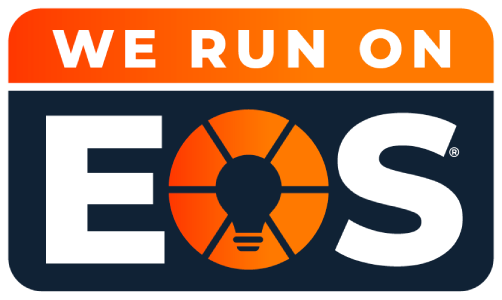EOS, which stands for Entrepreneurial Operating System, is a dynamic framework developed by Gino Wickman in 2000 to streamline operations and enhance organizational productivity. It comprises a set of practical tools and principles aimed at fostering clarity, accountability, and alignment across all company levels.
The onboarding process serves as the cornerstone for integrating new hires into the fabric of the organization. It goes beyond a mere orientation session, encompassing a strategic approach that acquaints employees with the company’s vision, values, culture, and operational procedures.
Comprehensive onboarding provides a strong foundation from the outset and ensures that employees understand their roles and responsibilities and how they contribute to the business’s overarching goals. This accelerates the integration of new talent and cultivates a sense of belonging and commitment among employees, ultimately driving long-term engagement and productivity.
Following effective onboarding milestones are a top priority in the context of EOS, where clarity and alignment are paramount. It lays the groundwork for individuals to embrace the EOS principles and actively contribute to the organization’s success, making it imperative for businesses utilizing the EOS model to prioritize and optimize their onboarding processes.

Understanding EOS Principles
The Entrepreneurial Operating System (EOS) is a comprehensive approach to organizational management and leadership that empowers businesses to achieve greater clarity, cohesion, and effectiveness. At its core, EOS is built upon three fundamental components, each serving as a cornerstone of its methodology. These components work synergistically to provide businesses with a framework for success in today’s dynamic and competitive landscape.
Vision
This aspect entails defining and articulating a clear, compelling picture of the organization’s long-term goals. It involves outlining the company’s core values, purpose, and long-term goals, which guide all decisions and actions within the organization.
Traction
This element focuses on execution and implementation, ensuring that the vision is translated into actionable steps and measurable results. It emphasizes establishing clear priorities, setting quarterly goals (Level 10 Meetings), and instilling discipline in executing key initiatives to drive progress and momentum toward the company’s vision.
Healthy
This refers to establishing a cohesive, high-performing team and organizational culture. It involves fostering open and honest communication, cultivating trust and accountability, and resolving issues effectively to create a positive and productive work environment.
How EOS Benefits New Hires
Aligning new hires with EOS principles is vital for ensuring their seamless integration into the organization and alignment with its overarching goals. By familiarizing new employees with the core components of EOS – Vision, Traction, and Healthy – organizations can instill a common language and framework for decision-making, enabling individuals to contribute effectively to the company’s success from the outset. Moreover, aligning new hires with EOS principles fosters a sense of shared purpose and collective ownership, facilitating collaboration and synergy across teams and departments.
Preparing for Onboarding
Preparing for onboarding is a critical step in ensuring the smooth integration of new hires into an organization. This preparation accelerates new employees’ time to proficiency and fosters engagement, productivity, and long-term retention. Effective onboarding begins with thoughtful preparation, laying the foundation for success and alignment with the organization’s goals and culture from day one. Here’s how you can ensure the process goes more smoothly.
Establish clear expectations from the outset
Before new hires embark on their onboarding journey, organizations must set clear expectations regarding roles, responsibilities, and performance standards. This involves defining job duties, outlining performance objectives, and communicating organizational values and culture. By establishing clear expectations upfront, organizations can ensure that new employees understand what is expected of them and can hit the ground running from day one.
Gather all the necessary resources and materials ahead of time
A great onboarding experience requires providing new hires with the tools, resources, and information they need to succeed in their new roles. This includes access to relevant documents, training materials, software systems, and other resources essential for performing their job responsibilities. By gathering and organizing these resources in advance, organizations can streamline the onboarding process and facilitate a smooth transition for new employees.
Assign each new hire a mentor or buddy
Giving new hires access to mentors or buddies can significantly enhance the onboarding experience by providing them with guidance, support, and a sense of belonging. Mentors or buddies can offer insights into company culture, help new employees navigate organizational dynamics, and serve as a point of contact for questions or concerns. By pairing new hires with experienced colleagues who can offer guidance and support, you can accelerate the integration process and foster strong relationships within your team.
The Onboarding Process
Consistent onboarding is the cornerstone of integrating new team members seamlessly into the fabric of an organization. It’s a pivotal phase where clarity, alignment, and cultural assimilation take precedence, setting the tone for a successful journey ahead. In the context of implementing the Entrepreneurial Operating System (EOS), a structured onboarding process becomes even more vital, as it ensures that new hires not only understand the principles and tools but also embody the ethos that drives the organization forward.
Orientation to EOS principles and company culture
New hires should undergo comprehensive orientation sessions to familiarize themselves with the core tenets of EOS and the company’s unique culture. This includes understanding the importance of vision, traction, and maintaining a healthy organizational environment.
Train new hires on EOS tools and processes
Employees receive hands-on training to navigate EOS tools and processes effectively. Whether it’s utilizing the Vision/Traction Organizer (V/TO), implementing Scorecards, or setting and achieving milestones, this training equips them with the necessary skills to contribute meaningfully to the EOS framework.
Introduce them to team members and key stakeholders
Be sure to introduce new hires to their colleagues, team members, and key organizational stakeholders. Building relationships early on fosters collaboration, encourages knowledge sharing, and promotes a sense of belonging within the team.
Provide shadowing opportunities for hands-on learning
Have new employees participate in shadowing opportunities to deepen their understanding of day-to-day operations and workflows. This hands-on experience allows them to observe and learn from seasoned professionals, gaining valuable insights into best practices and processes.
Schedule regular check-ins and feedback sessions

Conduct routine check-ups and solicit feedback throughout onboarding to gauge progress, address any concerns, and provide support as needed. These sessions facilitate open communication, ensure alignment with organizational goals, and enable continuous improvement in the onboarding experience.
Utilizing EOS Tools for Onboarding
Integrating new hires into the Entrepreneurial Operating System (EOS) ensures a seamless onboarding experience and lays the groundwork for aligning with the organization’s vision and objectives. Leveraging EOS tools during onboarding empowers new employees to understand, embrace, and contribute to the EOS framework from the onset, fostering clarity, accountability, and productivity. Here’s how to get started:
Integrate new hires into existing EOS processes
New hires should seamlessly integrate into the existing EOS processes, ensuring alignment with the organization’s operational structure and objectives. This integration allows them to understand their role within the EOS framework and how their contributions fit into the broader organizational goals.
Leverage tools like the V/TO (Vision/Traction Organizer) to provide clarity
The V/TO serves as a foundational tool for articulating the organization’s vision, core values, and long-term objectives. During onboarding, introduce new hires to the V/TO, providing them with clarity regarding the company’s direction and purpose and how their roles contribute to achieving these goals.
Use Scorecards to establish goals and expectations
In the EOS system, scorecards are instrumental in establishing clear goals, priorities, and expectations for new hires. Scorecards outline key performance metrics and objectives, allowing you to define quarterly priorities and initiatives. By aligning their goals and activities with the organization’s priorities, new employees can focus their efforts effectively and drive tangible results within the EOS framework.
Cultivating a Healthy EOS Environment
A healthy EOS environment fosters collaboration, innovation, and performance within an organization. Cultivating such an environment requires a deliberate focus on promoting open communication, accountability, and continuous employee support. By prioritizing these elements, organizations can create a workplace culture that empowers individuals to thrive, contribute meaningfully, and align with the Entrepreneurial Operating System (EOS) principles. These best practices will set your onboarding program up for success.
Encouraging open communication and feedback

Promote an environment that celebrates open communication. New hires should be encouraged to freely share their ideas, concerns, and feedback, fostering transparency and trust within the team. Regular feedback loops ensure that communication channels remain open at all levels, enabling continuous improvement and innovation.
Fostering a culture of accountability
Accountability is a cornerstone of a healthy EOS environment, where individuals take ownership of their actions and outcomes. Leaders set clear expectations and hold themselves and others accountable for meeting commitments and delivering results. By fostering a culture of accountability, organizations cultivate a sense of responsibility and integrity among employees, driving performance and achieving organizational goals.
Providing ongoing support and resources
Supporting employees with the resources they need to succeed is essential for maintaining a wholesome EOS environment. This includes offering training and development opportunities, access to tools and technology, and mentorship and coaching programs. By investing in the growth and development of employees, organizations demonstrate their commitment to their success and well-being, fostering loyalty and engagement.
Measuring Onboarding Success
Measuring the success of the onboarding process within the Entrepreneurial Operating System (EOS) framework is crucial for assessing its effectiveness and identifying areas for improvement. By establishing clear metrics, soliciting feedback, and leveraging data insights, organizations can refine their onboarding practices to better align with EOS principles and drive positive outcomes for new hires and the organization as a whole.
Establishing key metrics for onboarding effectiveness

Organizations define specific metrics to evaluate the success of their onboarding process, such as time to productivity, retention rates, and employee satisfaction scores. These metrics provide quantitative indicators of onboarding effectiveness and help organizations track progress toward their goals.
Soliciting feedback from new hires and stakeholders
Gathering feedback from new hires and key stakeholders provides valuable insights into the onboarding experience and highlights areas for improvement. Surveys, focus groups, and one-on-one discussions allow organizations to understand new hires’ perceptions, challenges, and suggestions for enhancing the onboarding process.
Adjusting processes based on insights and data
Organizations use insights from feedback and data analysis to identify gaps or pain points in the onboarding process and make necessary adjustments. This may involve refining training programs, updating documentation, or enhancing support resources to better meet the needs of new hires. Organizations can ensure that it remains effective and aligned with EOS principles by continuously iterating and improving the onboarding process based on insights and data.
Conclusion
Efficient onboarding isn’t just a one-time event but a continuous process requiring attention and refinement. Optimal onboarding is paramount within the Entrepreneurial Operating System (EOS) framework. It is the gateway for new hires to understand and embody the organization’s vision, values, and operational procedures.
Throughout this article, we’ve explored the critical components of effective onboarding within the EOS framework. From establishing clear expectations to leveraging EOS tools and fostering a healthy organizational environment, each aspect is vital in setting new hires up for success.
Continuous improvement lies at the heart of the EOS philosophy, and the same principle applies to onboarding practices. Organizations must constantly evaluate, solicit feedback, and adjust their processes based on insights and data to ensure that the onboarding experience remains aligned with EOS principles and drives positive outcomes for both new hires and the organization as a whole.
Investing in robust onboarding processes is not just an expense; it’s an investment in the organization’s future. Organizations prioritizing effective onboarding within the EOS framework can accelerate new hire integration, foster a culture of engagement and accountability, and ultimately drive long-term success and growth. Are you on the hunt for top-tier talent within the EOS framework? Try our process and see the results!


Reader Interactions